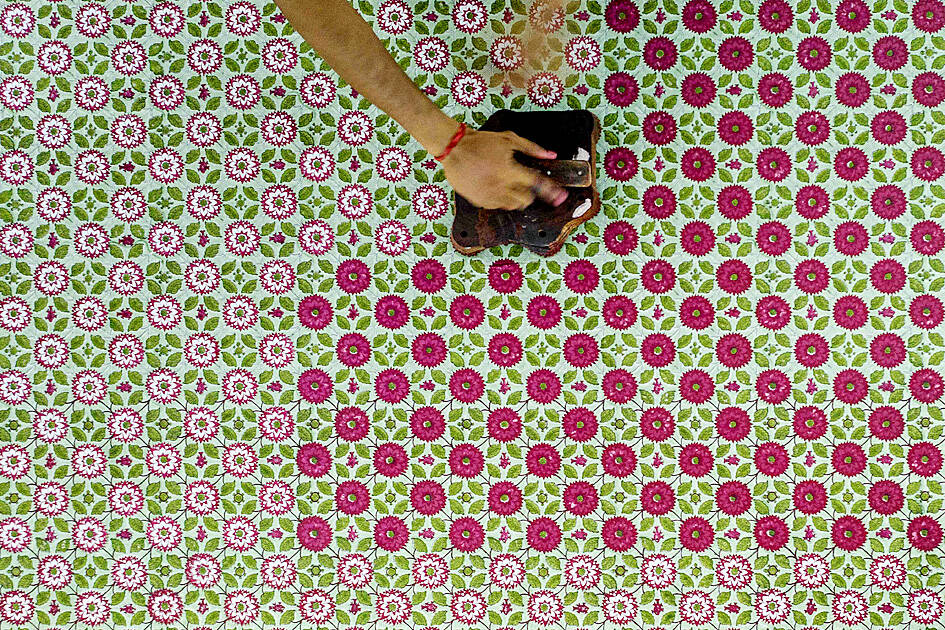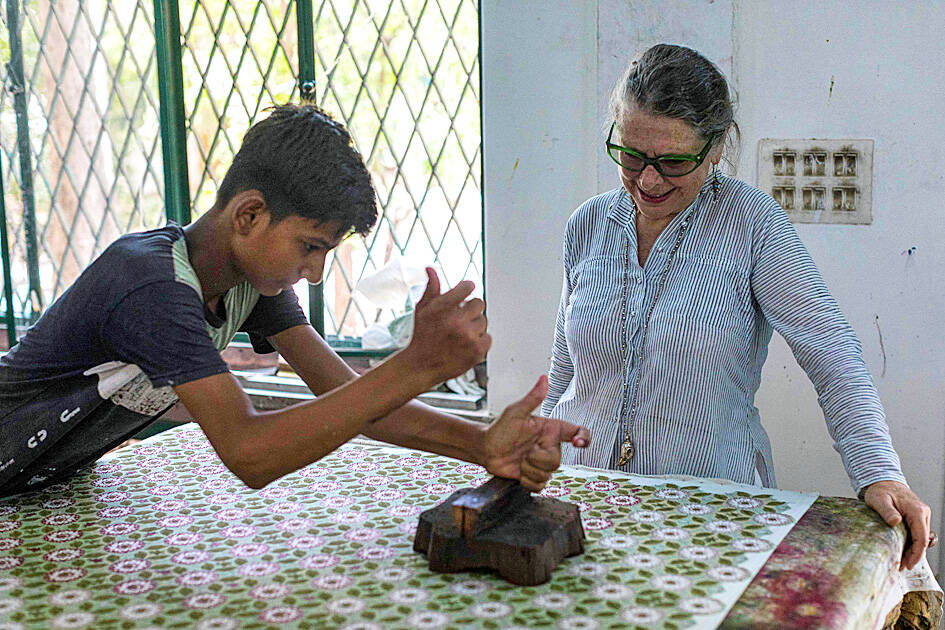Textiles designer Brigitte Singh lovingly lays out a piece of cloth embossed with a red poppy plant she said was probably designed for Mughal emperor Shah Jahan, builder of the Taj Mahal, four centuries ago.
For Singh — who moved from France to India 42 years ago and married into a maharaja’s family — this exquisite piece remains the ever-inspiring heart of her studio’s mission.
The 67-year-old is striving to keep alive the art of block printing, which flourished in the 16th and 17th centuries under the conquering, but sophisticated, Mughal dynasty that then ruled India.

Photo: AFP
“I was the first to give a renaissance to this kind of Mughal design,” Singh said in her traditional printing workshop in Rajasthan.
Having studied decorative arts in Paris, Singh arrived aged 25 in 1980 in western India’s Jaipur, the “last bastion” of the technique of using carved blocks of wood to print patterns on material.
“I dreamed of practicing [miniature art] in Isfahan, but the Ayatollahs had just arrived in Iran [in the Islamic revolution of 1979]. Or Herat, but the Soviets had just arrived in Afghanistan,” she said.

Photo: AFP
“So by default, I ended up in Jaipur,” she said.
A few months after arriving, Singh was introduced to a member of the local nobility who was related to the maharaja of Rajasthan. They married in 1982.
At first, Singh still hoped to try her hand at miniature painting, but after scouring the city for traditional paper to work on, she came across workshops using block printing.

Photo: AFP
“I fell into the magic potion and could never go back,” she said. She started by making just a few scarves, and when she passed through London two years later, gave them as presents to friends who were connoisseurs of Indian textiles. Bowled over, they persuaded her to show them to Colefax and Fowler, the storied British interior decorations firm.
“The next thing I knew, I was on my way back to India with an order for printed textiles,” she said.
For the next two decades, she worked with a “family of printers” in the city before building her own studio in nearby Amber — a stone’s throw from Jaipur’s famous fort.
It was her father-in-law, a major collector of Rajasthan miniatures, who gave her the Mughal-era poppy cloth connected to Shah Jahan.
Her reproduction of that print was a huge success the world over, proving especially popular with Indian, British and Japanese clients.
In 2014, she made a Mughal poppy print quilted coat, called an atamsukh — meaning “comfort of the soul” — that was later acquired by the Victoria and Albert Museum in London.
Another piece of her work is in the collection of the Metropolitan Art Museum in New York.
Singh starts her creative process by handing precise paintings to her sculptor, Rajesh Kumar, who then painstakingly chisels the designs onto blocks of wood.
“We need a remarkable sculptor, with a very serious eye,” she said. “The carving of the wood blocks is the key. This tool has the sophistication of simplicity.”
Kumar makes several identical blocks for each color used in each printed fabric.
“The poppy motif, for example, has five colors. I had to make five blocks,” he said. “It took me 20 days.”
At Singh’s workshop, six employees work on pieces of cloth laid out on tables 5m long.
They dip the blocks in dye, place them carefully on the cloth, push down and tap.
The work is slow and intricate, producing no more than 40m of material every day.
Her workshop makes everything from quilts to curtains and rag dolls to shoes.
Singh just finished another atamsukh for a prince in Kuwait.
“The important thing is to keep the know-how alive,” she said. “More precious than the product, the real treasure is the savoir faire.”

Shares in Taiwan closed at a new high yesterday, the first trading day of the new year, as contract chipmaker Taiwan Semiconductor Manufacturing Co (TSMC, 台積電) continued to break records amid an artificial intelligence (AI) boom, dealers said. The TAIEX closed up 386.21 points, or 1.33 percent, at 29,349.81, with turnover totaling NT$648.844 billion (US$20.65 billion). “Judging from a stronger Taiwan dollar against the US dollar, I think foreign institutional investors returned from the holidays and brought funds into the local market,” Concord Securities Co (康和證券) analyst Kerry Huang (黃志祺) said. “Foreign investors just rebuilt their positions with TSMC as their top target,

H200 CHIPS: A source said that Nvidia has asked the Taiwanese company to begin production of additional chips and work is expected to start in the second quarter Nvidia Corp is scrambling to meet demand for its H200 artificial intelligence (AI) chips from Chinese technology companies and has approached contract manufacturer Taiwan Semiconductor Manufacturing Co (TSMC, 台積電) to ramp up production, sources said. Chinese technology companies have placed orders for more than 2 million H200 chips for this year, while Nvidia holds just 700,000 units in stock, two of the people said. The exact additional volume Nvidia intends to order from TSMC remains unclear, they said. A third source said that Nvidia has asked TSMC to begin production of the additional chips and work is expected to start in the second

REVENUE PERFORMANCE: Cloud and network products, and electronic components saw strong increases, while smart consumer electronics and computing products fell Hon Hai Precision Industry Co (鴻海精密) yesterday posted 26.51 percent quarterly growth in revenue for last quarter to NT$2.6 trillion (US$82.44 billion), the strongest on record for the period and above expectations, but the company forecast a slight revenue dip this quarter due to seasonal factors. On an annual basis, revenue last quarter grew 22.07 percent, the company said. Analysts on average estimated about NT$2.4 trillion increase. Hon Hai, which assembles servers for Nvidia Corp and iPhones for Apple Inc, is expanding its capacity in the US, adding artificial intelligence (AI) server production in Wisconsin and Texas, where it operates established campuses. This

Garment maker Makalot Industrial Co (聚陽) yesterday reported lower-than-expected fourth-quarter revenue of NT$7.93 billion (US$251.44 million), down 9.48 percent from NT$8.76 billion a year earlier. On a quarterly basis, revenue fell 10.83 percent from NT$8.89 billion, company data showed. The figure was also lower than market expectations of NT$8.05 billion, according to data compiled by Yuanta Securities Investment and Consulting Co (元大投顧), which had projected NT$8.22 billion. Makalot’s revenue this quarter would likely increase by a mid-teens percentage as the industry is entering its high season, Yuanta said. Overall, Makalot’s revenue last year totaled NT$34.43 billion, down 3.08 percent from its record NT$35.52